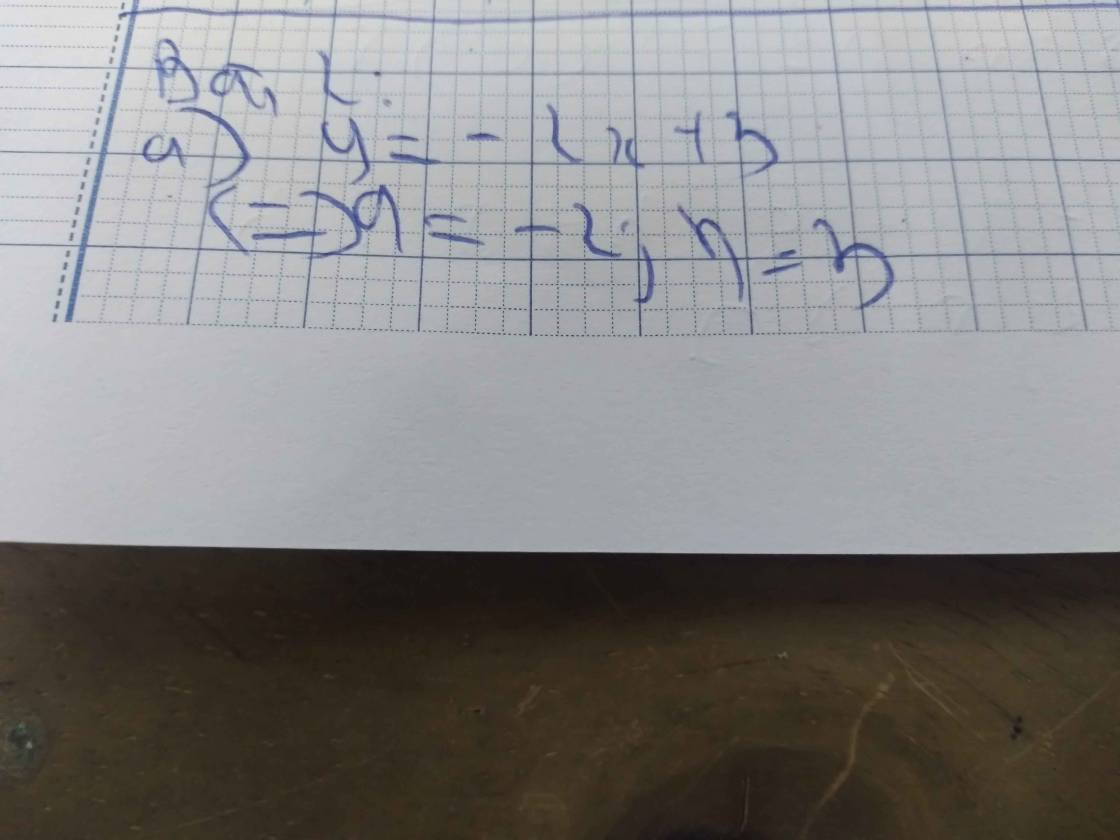1,Rút gọn
A=(\(\dfrac{2x+1}{x\sqrt{x}+1}\)-\(\dfrac{\sqrt{x}}{x-\sqrt{x}}\))x(x-\(\dfrac{x-4}{\sqrt{x}-2}\))
2,Xác định a,b để đồ thị hàm số y=ax+b đi qua điểm A(2;1) vàB(1;2)
Hãy nhập câu hỏi của bạn vào đây, nếu là tài khoản VIP, bạn sẽ được ưu tiên trả lời.

\(1,A=\dfrac{2x+1-x}{\left(\sqrt{x}+1\right)\left(x-\sqrt{x}+1\right)}\cdot\left(x-\sqrt{x}-2\right)\\ A=\dfrac{\left(x+1\right)\left(\sqrt{x}+1\right)\left(\sqrt{x}-2\right)}{\left(\sqrt{x}+1\right)\left(x-\sqrt{x}+1\right)}=\dfrac{\left(x+1\right)\left(\sqrt{x}-2\right)}{x-\sqrt{x}+1}\\ 2,\Leftrightarrow\left\{{}\begin{matrix}2a-b=1\\a-b=2\end{matrix}\right.\Leftrightarrow\left\{{}\begin{matrix}a=-1\\b=-3\end{matrix}\right.\Leftrightarrow y=-x-3\)

\(1,\\ A=1+\left[\dfrac{\left(2\sqrt{a}-1\right)\left(\sqrt{a}+1\right)}{\left(1-\sqrt{a}\right)\left(1+\sqrt{a}\right)}-\dfrac{\sqrt{a}\left(2\sqrt{a}-1\right)\left(\sqrt{a}+1\right)}{\left(1-\sqrt{a}\right)\left(a+\sqrt{a}+1\right)}\right]\cdot\dfrac{\sqrt{a}\left(\sqrt{a}-1\right)}{2\sqrt{a}-1}\\ A=1+\left[\dfrac{2\sqrt{a}-1}{1-\sqrt{a}}-\dfrac{\sqrt{a}\left(2\sqrt{a}-1\right)\left(\sqrt{a}+1\right)}{\left(1-\sqrt{a}\right)\left(a+\sqrt{a}+1\right)}\right]\cdot\dfrac{\sqrt{a}\left(\sqrt{a}-1\right)}{2\sqrt{a}-1}\\ A=1+\dfrac{\left(2\sqrt{a}-1\right)\left(a+\sqrt{a}+1\right)-\left(2\sqrt{a}-1\right)\left(a+\sqrt{a}\right)}{\left(1-\sqrt{a}\right)\left(a+\sqrt{a}+1\right)}\cdot\dfrac{\sqrt{a}\left(\sqrt{a}-1\right)}{2\sqrt{a}-1}\)
\(A=1+\dfrac{\left(2\sqrt{a}-1\right)\left(a+\sqrt{a}+1-a-\sqrt{a}\right)}{-\left(\sqrt{a}-1\right)\left(a+\sqrt{a}+1\right)}\cdot\dfrac{\sqrt{a}\left(\sqrt{a}-1\right)}{2\sqrt{a}-1}\\ A=1+\dfrac{-\sqrt{a}\left(2\sqrt{a}-1\right)}{\left(a+\sqrt{a}+1\right)\left(2\sqrt{a}-1\right)}\\ A=1-\dfrac{\sqrt{a}}{a+\sqrt{a}+1}=\dfrac{a+\sqrt{a}+1-\sqrt{a}}{a+\sqrt{a}+1}=\dfrac{a+1}{a+\sqrt{a}+1}\)

a: \(\lim\limits_{x\rightarrow2^+}\dfrac{\sqrt{x-2}+1}{x^2-3x+2}=+\infty\) vì \(\left\{{}\begin{matrix}\lim\limits_{x\rightarrow2^+}\sqrt{x-2}+1=\sqrt{2-2}+1=1>0\\\lim\limits_{x\rightarrow2^+}x^2-3x+2=\lim\limits_{x\rightarrow2^+}\left(x-1\right)\left(x-2\right)=0\end{matrix}\right.\)
=>x=2 là tiệm cận đứng của đồ thị hàm số \(y=\dfrac{\sqrt{x-2}+1}{x^2-3x+2}\)
b: \(\lim\limits_{x\rightarrow-5^+}\dfrac{\sqrt{5+x}-1}{x^2+4x}=\dfrac{\sqrt{5-5}-1}{\left(-5\right)^2+4\cdot\left(-5\right)}=\dfrac{-1}{25-20}=\dfrac{-1}{5}\)
=>x=-5 không là tiệm cận đứng của đồ thị hàm số \(y=\dfrac{\sqrt{5+x}-1}{x^2+4x}\)
\(\lim\limits_{x\rightarrow\left(-4\right)^+}\dfrac{\sqrt{5+x}-1}{x^2+4x}\)
\(=\lim\limits_{x\rightarrow\left(-4\right)^+}\dfrac{5+x-1}{\left(\sqrt{5+x}+1\right)\left(x^2+4x\right)}=\lim\limits_{x\rightarrow\left(-4\right)^+}\dfrac{x+4}{\left(\sqrt{5+x}+1\right)\cdot x\left(x+4\right)}\)
\(=\lim\limits_{x\rightarrow\left(-4\right)^+}\dfrac{1}{x\left(\sqrt{5+x}+1\right)}=\dfrac{1}{\left(-4\right)\cdot\left(\sqrt{5-4}+1\right)}=\dfrac{1}{-8}=-\dfrac{1}{8}\)
=>x=-4 không là tiệm cận đứng của đồ thị hàm số \(y=\dfrac{\sqrt{5+x}-1}{x^2+4x}\)
\(\lim\limits_{x\rightarrow0^+}\dfrac{\sqrt{5+x}-1}{x^2+4x}=+\infty\) vì \(\left\{{}\begin{matrix}\lim\limits_{x\rightarrow0^+}\sqrt{5+x}-1=\sqrt{5+0}-1=\sqrt{5}-1>0\\\lim\limits_{x\rightarrow0^+}x^2+4x=0\end{matrix}\right.\)
=>Đường thẳng x=0 là tiệm cận đứng của đồ thị hàm số \(y=\dfrac{\sqrt{5+x}-1}{x^2+4x}\)
c: \(\lim\limits_{x\rightarrow0^+}\dfrac{5x+1-\sqrt{x+1}}{x^2+2x}\)
\(=\lim\limits_{x\rightarrow0^+}\dfrac{\dfrac{5x+1-x^2-2x-1}{5x+1+\sqrt{x+1}}}{x\left(x+2\right)}\)
\(=\lim\limits_{x\rightarrow0^+}\dfrac{-x^2+3x}{\left(5x+1+\sqrt{x+1}\right)\cdot x\left(x+2\right)}\)
\(=\lim\limits_{x\rightarrow0^+}\dfrac{-x\left(x-3\right)}{x\left(x+2\right)\left(5x+1+\sqrt{x+1}\right)}\)
\(=\lim\limits_{x\rightarrow0^+}\dfrac{-x+3}{\left(x+2\right)\left(5x+1+\sqrt{x+1}\right)}=\dfrac{-0+3}{\left(0+2\right)\left(5\cdot0+1+\sqrt{0+1}\right)}\)
\(=\dfrac{3}{2\cdot\left(6+1\right)}=\dfrac{3}{14}\)
=>x=0 không là tiệm cận đứng của đồ thị hàm số \(y=\dfrac{5x+1-\sqrt{x+1}}{x^2+2x}\)
\(\lim\limits_{x\rightarrow\left(-2\right)^+}\dfrac{5x+1-\sqrt{x+1}}{x^2+2x}\) không có giá trị vì khi x=-2 thì căn x+1 vô giá trị
=>Đồ thị hàm số \(y=\dfrac{5x+1-\sqrt{x+1}}{x^2+2x}\) không có tiệm cận đứng
d: \(\lim\limits_{x\rightarrow0^+}\dfrac{\sqrt{4x^2-1}+3x^2+2}{x^2-x}\) không có giá trị vì khi x=0 thì \(\sqrt{4x^2-1}\) không có giá trị
\(\lim\limits_{x\rightarrow1^+}\dfrac{\sqrt{4x^2-1}+3x^2+2}{x^2-x}\)
\(=+\infty\) vì \(\left\{{}\begin{matrix}\lim\limits_{x\rightarrow1^+}\sqrt{4x^2-1}+3x^2+2=\sqrt{4-1}+3\cdot1^2+2=5+\sqrt{3}>0\\\lim\limits_{x\rightarrow1^+}x^2-x=0\end{matrix}\right.\)
=>x=1 là tiệm cận đứng của đồ thị hàm số \(y=\dfrac{\sqrt{4x^2-1}+3x^2+2}{x^2-x}\)

a: \(\lim\limits_{x\rightarrow+\infty}y=\lim\limits_{x\rightarrow+\infty}\dfrac{\sqrt{9x^2+x}+x}{2x+5}\)
\(=\lim\limits_{x\rightarrow+\infty}\dfrac{\sqrt{9+\dfrac{1}{x}}+1}{2+\dfrac{5}{x}}=\dfrac{\sqrt{9}+1}{2}=\dfrac{3+1}{2}=2\)
=>Đường thẳng y=2 là tiệm cận ngang của đồ thị hàm số \(y=\dfrac{\sqrt{9x^2+x}+x}{2x+5}\)
\(\lim\limits_{x\rightarrow-\infty}y=\lim\limits_{x\rightarrow-\infty}\dfrac{\sqrt{9x^2+x}+x}{2x+5}\)
\(=\lim\limits_{x\rightarrow-\infty}\dfrac{-\sqrt{9+\dfrac{1}{x}}+1}{2+\dfrac{5}{x}}=\dfrac{-3+1}{2}=\dfrac{-2}{2}=-1\)
=>Đường thẳng y=-1 là tiệm cận ngang của đồ thị hàm số \(y=\dfrac{\sqrt{9x^2+x}+x}{2x+5}\)
b: \(\lim\limits_{x\rightarrow+\infty}y=\lim\limits_{x\rightarrow+\infty}\dfrac{\sqrt{2x^2+1}-x}{x+2}\)
\(=\lim\limits_{x\rightarrow+\infty}\dfrac{\sqrt{2+\dfrac{1}{x^2}}-1}{1+\dfrac{2}{x}}=\dfrac{\sqrt{2}-1}{1}=\sqrt{2}-1\)
=>Đường thẳng \(y=\sqrt{2}-1\) là tiệm cận ngang của đồ thị hàm số \(y=\dfrac{\sqrt{2x^2+1}-x}{x+2}\)
\(\lim\limits_{x\rightarrow-\infty}y=\lim\limits_{x\rightarrow-\infty}\dfrac{\sqrt{2x^2+1}-x}{x+2}\)
\(=\lim\limits_{x\rightarrow-\infty}\dfrac{-\sqrt{2+\dfrac{1}{x^2}}-1}{1+\dfrac{2}{x}}=\dfrac{-\sqrt{2}-1}{1}=-\sqrt{2}-1\)
=>Đường thẳng \(y=-\sqrt{2}-1\) là một tiệm cận ngang của đồ thị hàm số \(y=\dfrac{\sqrt{2x^2+1}-x}{x+2}\)

a: ĐKXĐ: x^2-2x<>0 và x^2-1>0
=>(x>1 và x<>2) hoặc x<-1
b: ĐKXĐ: x+1>0 và 5-3x>0
=>x>-1 và 3x<5
=>-1<x<5/3
c: DKXĐ: 5x+3>=0 và 3-x>0
=>x>=-3/5 và x<3
=>-3/5<=x<3
d: ĐKXĐ: 4-x^2>0 và 1+x>=0
=>x^2<4 và x>=-1
=>-2<x<2 và x>=-1
=>-1<=x<2
e: ĐKXĐ: 2-3x<>0 và 1-6x>0
=>x<>2/3 và x<1/6
=>x<1/6

Bài 1 : Đồ thị đi qua điểm M(4;-3) \(\Rightarrow\) y=-3 x=4. Ta được:
\(-3=4a+b\)
Đồ thị song song với đường d \(\Rightarrow\) \(a=a'=-\dfrac{2}{3}\) Ta được:
\(-3=4.-\dfrac{2}{3}+b\) \(\Rightarrow\) \(b=-\dfrac{1}{3}\)
Vậy: \(a=-\dfrac{2}{3};b=-\dfrac{1}{3}\)
b) (P) đi qua 3 điểm A B O, thay tất cả vào (P), ta được hpt:
\(\hept{\begin{cases}a+b+c=1\\a-b-c=-3\\0+0+1=0\end{cases}\Leftrightarrow\hept{\begin{cases}a=-1\\b=2\\c=0\end{cases}}}\)
Bài 2 : Mình ko biết vẽ trên này, bạn theo hướng dẫn rồi tự làm nhé
Đồ thị có \(a< 0\) \(\Rightarrow\) Hàm số nghịch biến trên R
\(\Rightarrow\) Đồ thị có đỉnh \(I\left(1;4\right)\)
Chọn các điểm:
x 1 3 -1 2 -2
y 4 0 0 3 -5

Bài 1:
a) \(\dfrac{a+\sqrt{a}}{\sqrt{a}}=\sqrt{a}+1\)
b) \(\dfrac{\sqrt{\left(x-3\right)^2}}{3-x}=\dfrac{\left|x-3\right|}{3-x}=\pm1\)
Bài 2:
a) \(\dfrac{\sqrt{9x^2-6x+1}}{9x^2-1}=\dfrac{\left|3x-1\right|}{\left(3x-1\right)\left(3x+1\right)}=\pm\dfrac{1}{3x+1}\)
b) \(4-x-\sqrt{x^2-4x+4}=4-x-\left|x-2\right|=\left[{}\begin{matrix}6-2x\left(x\ge2\right)\\2\left(x< 2\right)\end{matrix}\right.\)

\(A=\left(\dfrac{\sqrt{x}}{\sqrt{x}+3}+\dfrac{2x}{9-x}\right):\left(\dfrac{\sqrt{x}+1}{x-3\sqrt{x}}-\dfrac{2}{\sqrt{x}}\right)\left(x>0,x\ne9\right)\)
\(=\left(\dfrac{\sqrt{x}}{\sqrt{x}+3}+\dfrac{2x}{\left(3-\sqrt{x}\right)\left(\sqrt{x}+3\right)}\right):\left(\dfrac{\sqrt{x}+1}{\sqrt{x}\left(\sqrt{x}-3\right)}-\dfrac{2}{\sqrt{x}}\right)\)
\(=\dfrac{\sqrt{x}\left(3-\sqrt{x}\right)+2x}{\left(3-\sqrt{x}\right)\left(\sqrt{x}+3\right)}:\dfrac{\sqrt{x}+1-2\left(\sqrt{x}-3\right)}{\sqrt{x}\left(\sqrt{x}-3\right)}\)
\(=\dfrac{x+3\sqrt{x}}{\left(3-\sqrt{x}\right)\left(\sqrt{x}+3\right)}:\dfrac{7-\sqrt{x}}{\sqrt{x}\left(\sqrt{x}-3\right)}\)
\(=\dfrac{\sqrt{x}\left(\sqrt{x}+3\right)}{\left(3-\sqrt{x}\right)\left(\sqrt{x}+3\right)}.\dfrac{\sqrt{x}\left(\sqrt{x}-3\right)}{7-\sqrt{x}}=\dfrac{x}{\sqrt{x}-7}\)
\(B=\left(\dfrac{1}{x+\sqrt{x}}-\dfrac{1}{\sqrt{x}+1}\right):\dfrac{\sqrt{x}-1}{x+2\sqrt{x}+1}+1\left(x>0,x\ne1\right)\)
\(=\left(\dfrac{1}{\sqrt{x}\left(\sqrt{x}+1\right)}-\dfrac{1}{\sqrt{x}+1}\right):\dfrac{\sqrt{x}-1}{\left(\sqrt{x}+1\right)^2}+1\)
\(=\dfrac{1-\sqrt{x}}{\sqrt{x}\left(\sqrt{x}+1\right)}.\dfrac{\left(\sqrt{x}+1\right)^2}{\sqrt{x}-1}+1=-\dfrac{\sqrt{x}+1}{\sqrt{x}}+1\)
\(=\dfrac{\sqrt{x}-\sqrt{x}-1}{\sqrt{x}}=-\dfrac{1}{\sqrt{x}}\)

